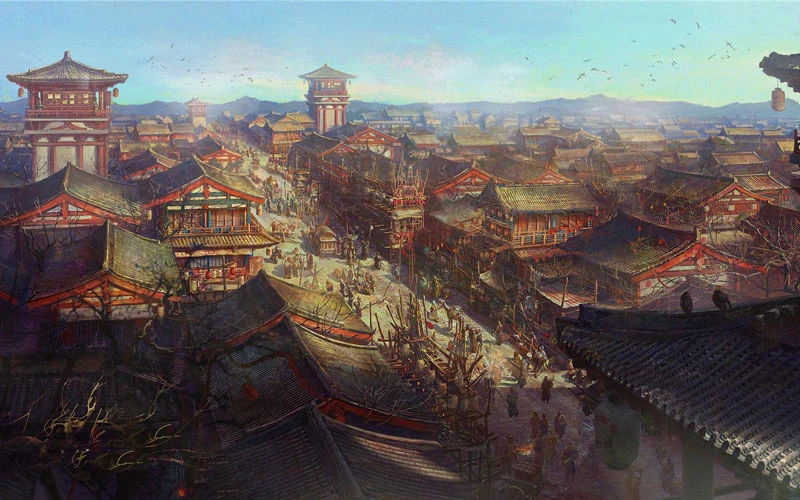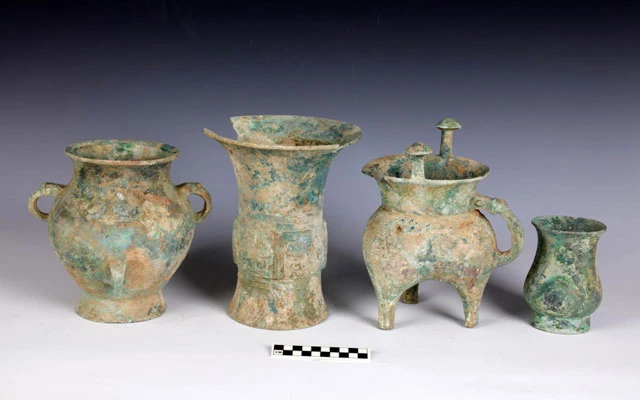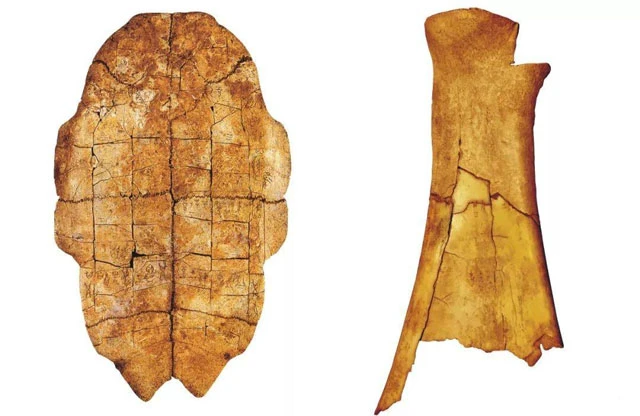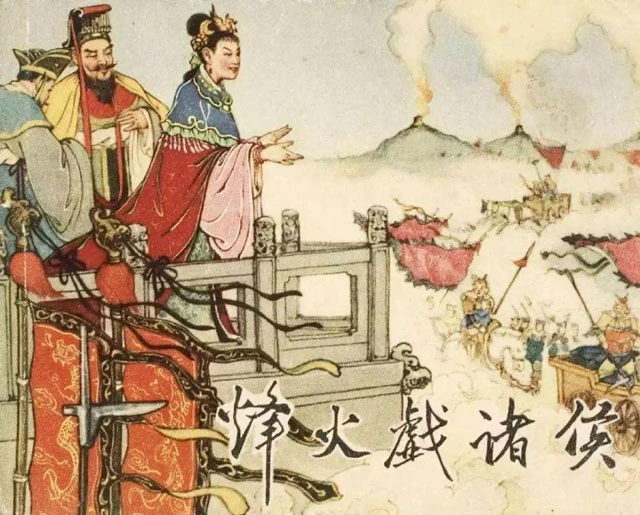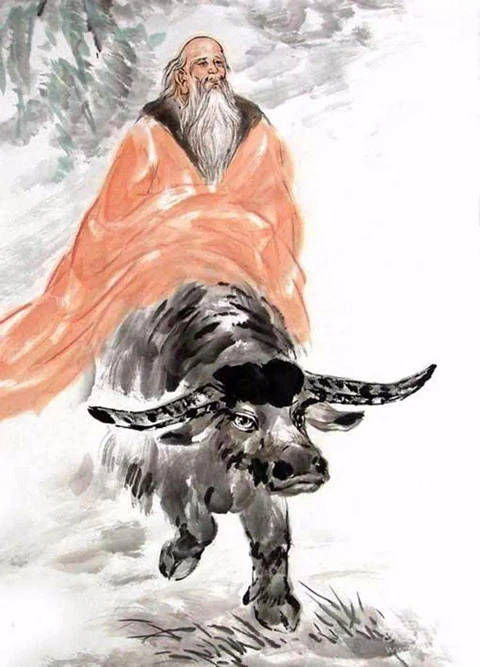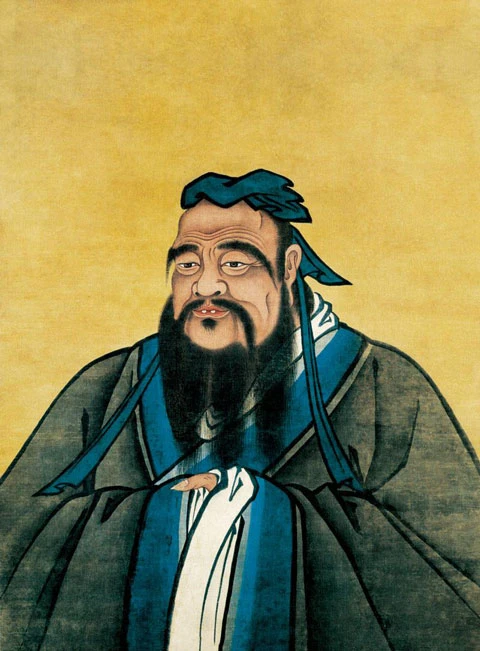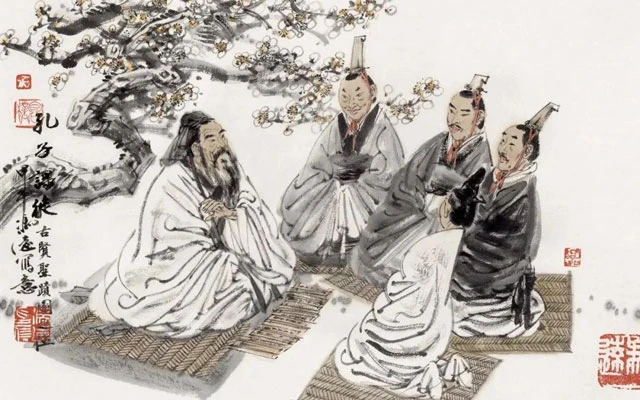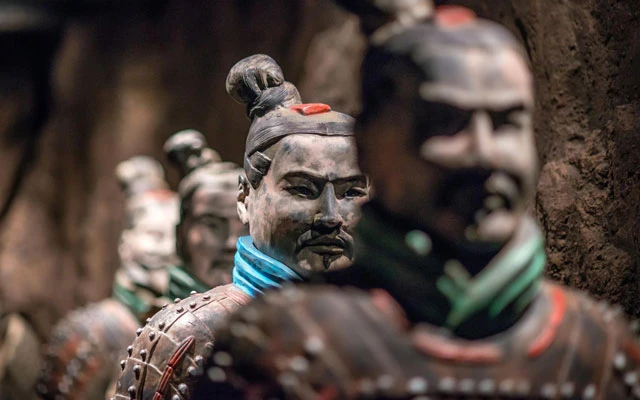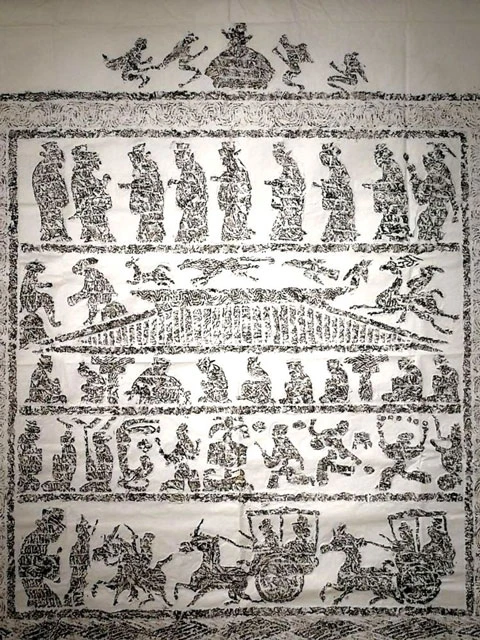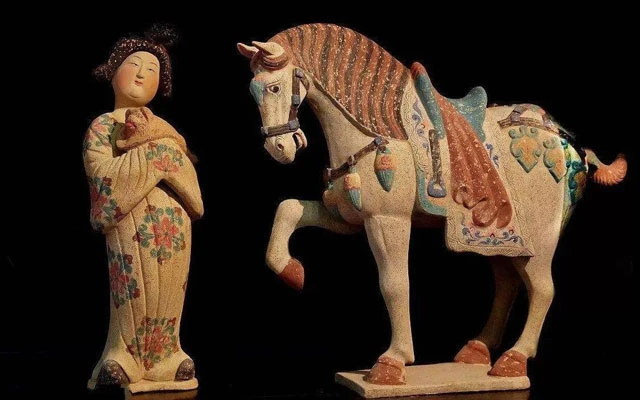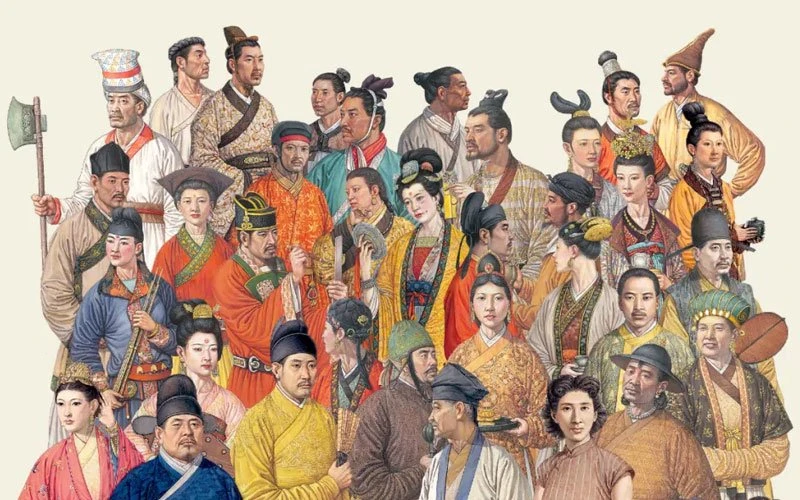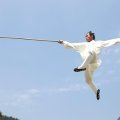The Chinese culture forms a world apart from strong isolation. Only in prehistoric times, especially the Neolithic, can we point to any contact between such distant worlds. The pottery with painted spirals of the Chinese Yang-Chao culture, in the 3rd millennium, resembles that of Southern Russia and the Danube at the same time. It has been brought from the West, perhaps by the first Chinese, farmers and herdsmen arriving from the Turkestan districts, where they were in contact with Caucasians and Indo-Germans and with other Mughal groups, the Uralo-Altaic and Turkic.
Early History of Chinese Culture
People were already living in the large region we now call China long before the beginning of recorded history. About 9,000 years ago, the ancestors of today's Chinese created agricultural settlements near two mighty rivers, the Yellow River and the Yangtze.
Near the northernmost Yellow River, the earliest agricultural settlements consisted of wooden houses plastered with mud and roofed with reeds. Farmers cultivated a plant called millet, as well as fished in the river and hunted.
Further south, people built houses on stilts in the swampy land near the Chang Jiang or "Long River". They grew rice on the waterlogged land and archaeologists have found an early settlement dated to 6000-5000 BC. The excavated artifacts reveal that these early Chinese used stone tools and raised water buffalo, pigs, and dogs.
The emigration of Chinese culture must be placed in relation to the movements of peoples in the 3rd millennium, one of which brought the Tocharians (Indo-Europeans) to eastern Turkestan. The emigration of Chinese culture must have been rapid, and the Chinese preserved mythical accounts of their origins and of their arrival in the territory through the Gobi desert. In the middle of the 3rd millennium they arrived in the Hoang-ho region, under the command of the patriarch Yao.
Then the Hia and Chang or Yin dynasties were formed, during which they occupied a fertile area between the Hoang-ho and the Yang-Tse-Kiang.
The Shang dynasty
Around 3000 BC, the inhabitants of these settlements were beginning to protect them with earthen walls. Communities grew larger under the leadership of strong rulers, many of whom appear in the legends of Chinese culture. Rulers passed power to their brothers or sons. The first dynasty to leave historical evidence was the Shang Dynasty.
The Shang dynasty, which ruled a wide area around the Huang He River, dates from 1766 B.C. Around this time, the Chinese learned to make bronze, and the people of the Shang period used this knowledge to make tools, weapons and vessels.
The people of the Shang period were ruled by a priest-king who was called "Son of Heaven". The spirits of the royal ancestors were worshipped and consulted on the most important decisions; there were also many gods, especially the sun - considered a father figure - and the earth, a mother figure. Shang kings and their nobles hunted deer, wild boar, tigers and wolves.
It is thought that they had several capitals, one after the other, and it is known that around 1400 BC they made Anyang their capital.
Anyang, capital of Chinese culture at the time of the Shang Dynasty
Anyang grew into a symmetrical city outside the city, with palaces and temples for the king and nobles, who traveled in luxury in horse-drawn carriages. The houses of the ordinary people were made of adobe and reeds, with thatched roofs.
Many Shang relics have been found in Anyang, including more than 10,000 pieces of bone and tortoise shell covered with script. Shang script has more than 3,000 signs and was an ancient form of Chinese pictographic writing.
These bones and tortoise shell fragments are called oracular bones, as they were used as a means of contacting the gods. Questions were written on them and then heated until they broke. The priests examined the fragments and, supposedly, the shape of the fragments answered the questions.
To the west, the territory was ruled by another dynasty, called the Chou, whom the Shang considered barbarians. Nevertheless, the two groups coexisted peacefully for many years. Then the Chou tribal warriors fought long and hard against the Shang and eventually defeated them.
The Chou dynasty in Chinese Culture
The Chou became the ruling dynasty around 1050 BC, and the ruler divided his kingdom into more than a hundred states, each led by a local chief. To control the new lands, the Chou rulers created a feudal system some 2,000 years before anything similar appeared in Europe.
Below the ruler, the Chou ruling class consisted of five categories of nobles. Each category leased land from the nobles of the category immediately above them and all the land was worked by commoners, who also had to look after their own land, assisted by the lowest class of Chou society, the slaves.
The ruler resided in the capital, Hao, near present-day Chi'an, close to the banks of the Huang He River. Each Chou ruler was succeeded by his eldest son and all strove to keep the states united.
The fall of Yu
However, in the 8th century BC a weak Chou ruler caused trouble., his name was "Yu". He spent much of his time with his mistress and his behavior greatly angered the nobles, especially those who were related to his wife. Finally, they lost patience with him and overthrew him.
A legend from Chinese culture provides us with a colorful account of Yu's downfall. According to the story, one day Yu decided to play a prank to amuse his mistress. He ordered fires to be lit on top of the hills surrounding the capital, which was the agreed signal to warn the nobles that the capital was in danger of being attacked. The nobles immediately sent their armies, only to find that there was no such threat and that it was all a joke. While Yu and her lover found the soldiers' anger amusing, others were less amused.
Yu's father-in-law was particularly angry. He gathered an army from among the western tribes and led an invasion for real. Yu ordered the bonfires to be lit again, but this time the nobles ignored the signal. Yu was killed and his mistress kidnapped by the warriors.
The succession of Yu's son
In 771 BC, Yu's son - the new ruler - moved the Chou capital further east to Luoyang. The individual states of the Chou kingdom began by then to separate territorially, going to war with each other more and more often. Ambitious local lords fought for power, which led to increasing disorder.
In this situation of national instability, many ideologists tried to find ways to make the people live in harmony. Among them were two men whose ideas would have a lasting impact on Chinese life: Laozi and Confucius.
The Age of Chinese Cultural Philosophy
Laozi
Laozi (a name meaning "Ancient Philosopher") lived in the 6th century B.C. Little is known about him other than legends, but we know that he believed that the most important thing for people was to live their lives as simply as possible and in harmony with nature. His Tao or "Way" contains patterns of nature and his later followers, called Taoists, tried to live according to his teachings.
According to legend, Laozi tried to leave his home state of Honan when he was an old man. But the border guardian, who was a great admirer of the Tao, would not let him leave until he had written down its teachings, which were known only by word of mouth. Laozi agreed and wrote 81 short poems, which have been studied ever since. Experts believe that this book, entitled Te Ching ("The Classic of the Way and Virtue") was probably written by Taoist followers hundreds of years later.
Confucius
Confucius (551-479 B.C.) is the Latin version of the Chinese title Kongfuzi, meaning "Great Teacher Kong." It is the title given to Confucius, born Kong Qui, in the Chou State of Lu. Confucius' father died when he was still very young and he worked hard to help his mother. He spent his time studying, as well as practicing archery and music.
When he was 22, Confucius became a teacher of history and poetry. Besides that, he taught his students how to reflect on their lives and how they should live better. These teachings are why he still has a following 2,500 years later.
Confucius' fears
Confucius was afraid that quarrels and wars between the different Chou states would lead to the demise of civilization.
He believed that society could be saved if it concentrated on sincerity and honesty. Confucius was given some minor posts in Lu, but the governor of the state ignored his advice and Confucius resigned around 496 B.C. He went into exile with several of his followers and for 13 years toured the various courts of the kingdom.
Spread of Confucius' ideas
Towards the end of his life, Confucius spent his time teaching and writing, but it is not clear whether any of his writings have survived. However, his disciples put his sayings in writing in a book entitled Analects.
When Confucius died, he was not well known. His followers spread his ideas and around 200 B.C. his teachings began to have great influence on the way China was governed.
By the time of his death, Confucius already saw that many of the things he feared had come true.
End of the Chou dynasty
In 479 B.C. the Chou dynasty found it difficult to control its territory of seven warring states. There were devastating battles between huge armies with horse-drawn chariots, bronze weapons and crossbows. The armies numbered a total of more than six million soldiers, and in a later battle in 260 B.C., more than half a million combatants were killed.
The long reign of the Chou rulers ended four years later, when the warring states began to fight.
Among these provinces the northwestern state of Qin proved to be the fiercest and best disciplined militarily. In 221 BC, its governor, Cheng, was able to declare himself victorious over all his rivals and called himself Qin Shi Huang: "The first emperor of Qin".
The Qin Dynasty
The first emperor of Chinese Culture
Shihuangdi became the first emperor of a unified China (the modern name of the country comes from the word Qin). Qin Shi Huang established central control and took all power back. He divided China into new districts and the officials who ran them answered directly to him. He also ordered the construction of a network of roads, canals and bridges throughout the empire. He then sent huge numbers of workers to build a great wall in the northern part of the empire, to keep out potential invading armies.
The "First Emperor" tried to unify everything possible in the empire. He introduced standard weights and measures and made sure that the characters of the Chinese culture language were written in the same way everywhere. He then ordered large bonfires to be set up so that all known texts could be burned, except those on useful subjects such as medicine, pharmacy and fortune-telling. The reason was to destroy books written by people who criticized his rule and to destroy all knowledge of the past. Scholars who objected were thrown into a deep pit and died by the hundreds.
Protection of Shihuangdi
He was a tough politician and a strong general, but he was afraid of death. In his great palace there were more than 1,000 sleeping quarters, so that he could sleep in a different one every night, in case someone wanted to kill him. A special tomb was also built, so that he would be protected after his death. His tomb contained an army of more than 7,000 life-size terracotta soldiers, chariots and horses. This terracotta army carried real bronze weapons, but they were stolen by tomb robbers.
The Han Dynasty
The Rise of the Han in Chinese Culture
Qin Shi Huang died in 210 B.C., having been emperor for only 11 years; his son had proven to be a weak leader. Rebellions continued, and in 202 BC a new dynasty, the Han dynasty, seized power.
The first emperor of the Han dynasty was Liu Bang, from the most ordinary peasant family. Liu organized regional provinces similar to those of the Chou era and made peace with the tribes that had threatened to invade China from Mongolia. Liu was not a cultivated man, but he ended the harsh laws of the "First Emperor". The Han dynasty ruled the Chinese Empire for more than 400 years and most Chinese today still call themselves Han.
The Han emperors believed in a strong and highly centralized government. Emperor Wu Ti, who ruled between 140 and 87 BC was determined to improve the quality of his bureaucracy and introduced competitive examinations to elect officials. He also established an imperial university for students to study the Confucian classics, which eventually became the philosophy of the state.
During Wu Ti's rule, the arts flourished. Han poets wrote in a particularly clear style that is still famous in the literature of Chinese culture, while artists of the time produced beautiful glazed pottery and stone engravings. Most of these artists, teachers, philosophers, and officials lived in the Han capital, Changan, which, like all ancient Chinese cities, was laid out in a symmetrical and orderly style.
End of the Han dynasty
In 25 AD, the Han capital was moved to Luoyang. Around 125 AD, Han's desire to maintain order was supported by the invention of paper, which made record-keeping much easier. The Han Empire continued to grow for some time, but eventually collapsed due to rivalries between generals, imperial advisors and officials. The Han dynasty ended in 220 AD, and for the next 400 years, China was once again filled with war and division.
The Sui Dynasty
China was reunified during the short rule of the Sui dynasty, between 581 and 618 A.D. Around this time, the canal system that had been started hundreds of years earlier was rebuilt and expanded. By A.D. 610, Chinese engineers had planned and built the Grand Canal to link the Huang He with more southerly rivers. This massive canal made transporting rice and other foodstuffs from the south to the north of the empire, where most of the population lived, easier. The great canal of the Sui dynasty was carried even further south in later years, and is still in use.
The Tang Dynasty
In 618 A.D., the Tang dynasty took control of the empire. The Tang dynasty would last nearly 300 years, in what was a Golden Age for China. During the rule of the Tang emperors, the imperial capital, Changan, grew to become the largest city in the world, home to more than a million people. Many merchants and scholars from the rest of Asia visited. Buddhism, which had come to China from India a few centuries earlier, began to flourish.
In this era of prosperity, wealthy people lived a comfortable life. They lived in brick and wooden houses two or three stories high, surrounded by beautiful courtyards and gardens, wore luxurious silk costumes and had plenty of leisure time. They liked to listen to music and poetry, as well as play chess and cards.
They bought gold, silver and jade goods, and were especially fond of porcelain bowls, cups and other vessels. The most delicate porcelain was intended for the emperor's use, second-rate porcelain was used by the emperor to make gifts, while third-rate porcelain was for everyday use.
Expansion of markets
In the Tang period, China expanded its borders and traded with other lands. Many merchants traveled to and from Central Asia, Persia and the Mediterranean Sea along the Silk Road, a route of more than 6,000 kilometers.
The goods that Chinese merchants brought to the West were silk, paper and porcelain, while foreign merchants brought wool and precious metals to China. Changan markets were always busy and the increased trade brought more prosperity to the empire's artisans and farmers.
A lot of ordinary people also improved during Tang rule and those who excelled in intelligence were able to rise through the ranks by passing examinations and gaining a position in the civil service.
But again a period of great political turmoil shook China. In 868 there was a military rebellion against the Tang dynasty and 13 years later the rebels conquered Changan. The governors of the provinces declared their independence from the central government, and in 907 the last emperor of the Tang Dynasty was overthrown.
The content of the Tang to Qing dynasties will continue to be updated afterwards.
More about ancient China history you may like:
